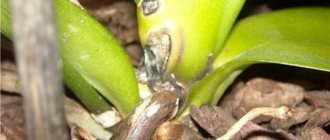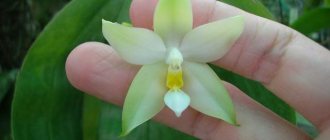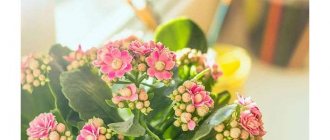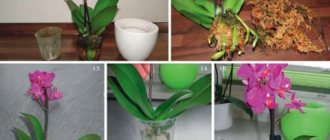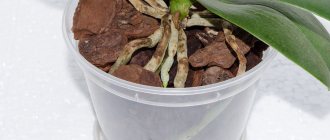With the arrival of spring, vitamin deficiency occurs, not only in people, but also in plants. A lack of sunlight leads to depletion of orchids , which is why it is so important to support them with additional feeding with vitamins.
A vitamin cocktail will help restore the orchid to its normal appearance. However, not all vitamins are suitable for plants. And how to use them correctly to achieve the best results, which recipe to choose - is written in this article.
Biological role
Vitamins are organic compounds that perform important biological and biochemical roles. Initially, biologists considered them necessary only for animal organisms, but now there is no doubt that plants also need them for normal life. These substances are synthesized from inorganic elements inside flowers, but can also be absorbed in ready-made form.
Vitamins are needed in minimal quantities; they are not needed to build new cells and do not increase energy, but their main function is to establish normal metabolism. It is clear that without this it will not be possible to properly increase the green mass, transfer the generated energy and perform all natural functions.
These organic compounds differ in their formulas. In nature, they are more likely to reach the roots than when grown indoors. At home, when a flower grows in a limited volume of soil, vitamins can only get in one way - if a person adds them to the water.
With vitamin deficiency, there is a disruption in the transfer of all necessary substances through cell membranes. This means a deficiency of all important elements, a slow deterioration in the condition of the plant until its death.
Vitamin cocktail for orchids
Plants are living organisms just like humans. Naturally, for normal growth they need organic compounds such as vitamins . They contribute to better absorption of microelements, the development of the orchid, its health and, as a result, more confident and lush flowering. Some vitamins help retain moisture in plant tissues, which helps them adapt better and faster to new or changing conditions.
Features of application
Feeding with vitamins is usually similar to “feeding” a person. Vitamins are used during crises, light deficits, exhaustion or illness.
Recovery of an orchid can be quite slow after the use of pesticides; vitamins help neutralize the negative substances of chemical treatments. Vitamins can somehow stimulate systems in a plant, activating certain functions.
Forms
Vitamins are often included in complex fertilizers or stimulants sold in flower shops. But you can also use pharmaceutical drugs, since in this form they are much cheaper.
All vitamin groups are divided into fat-soluble and water-soluble. The plant organism absorbs and transports mainly water-soluble ones. These include the following categories:
- complex B;
- C (ascorbic acid);
- PP (nicotinic acid).
The need for these compounds differs at different stages: for example, during seed germination the most vitamin preparations are needed, but they are synthesized inside the seedlings themselves, since the plant is not yet able to take them from the outside due to the lack of suction roots. Also, when growing in unfavorable conditions, a flower may need more than when living in a good environment.
Functions
Each vitamin has its own effect, but ultimately, vitamin deficiency always manifests itself externally in slower growth, the appearance of smaller leaves, shedding of buds, inflorescences, leaf blades and unripe fruits.
But scientists have clearly defined the role of each such substance in plant life.
Group B
The compounds that are combined into this large group differ from the rest in that their formula contains a nitrogen atom:
- B1 (thiamine ). Necessary for normal tolerance of stressful conditions and stimulation of flower growth. Helps to use energy efficiently and accelerates the circulation of intercellular fluid. It is considered the best antioxidant for indoor crops. Strengthens the branching of the root system.
- B6 (pyridoxine ). Activates the immune system, makes it possible to strengthen weakened or diseased inflorescences. The need for it increases sharply during recovery from viral or fungal diseases. It is also recommended to use pyridoxine immediately after insect control treatments. Gives excellent results for fruiting indoor plants such as lemons, kumquats, pomegranates, etc.
- B12 (cobalamin) . Necessary for the production of chlorophyll, ensures normal absorption of substances and metabolism, accelerates growth. Saturates cells with oxygen, comes to the rescue during long rainy or cloudy periods when plants suffer from lack of sunlight.
Ascorbic acid
Vitamin C is no less important for flowers than for people. It participates in respiration processes, acting as an intermediate catalyst for redox processes in tissues. Its main function is the transfer of hydrogen from the cell to the intercellular fluid. Resistance to negative environmental factors and various infections with a lack of ascorbic acid is sharply reduced. This substance helps in the fight against chlorosis; it allows flowers to neutralize harmful ultraviolet rays.
RR
This name hides the usual vitamin B3 or nicotinic acid. Used after a long period of depression for rapid recovery. It is considered a kind of “reanimation” for indoor flora that have experienced drought, suffered from intense light, or have been in a cold room for a long time. Gives impetus to the development of reproductive organs.
Where to buy
All these drugs can be easily purchased without a prescription at any pharmacy. When purchasing, you can use the common name (for example, vitamin B12) or the pharmaceutical name (cobalamin). Vitamins for indoor flowers are sold in ampoules in liquid form or in tablets. It is more convenient to dilute solutions in liquid form, which makes them easier to dose.
How to cook
There are many options for preparing nutrient solutions. First, it is recommended to try a monovariant, when only one drug is diluted. Then you can move on to multicomponent compositions. It must be remembered that vitamins for indoor flowers at home complement each other, and their effect is enhanced when they are present in a solution in a complex.
Typically, 1 ml of ampoule substance is completely dissolved in 1 liter of water at room temperature. It is best to use distilled or purified water without chlorides. When making fertilizer from an acetylsalicylic acid tablet per 1 liter of water, take ¼ tablet.
Sometimes Undevit dragees are used. It contains vitamins B, C, A and E. For the required concentration, take 2 tablets, grind them to a powder and also dilute them in 1 liter of water.
There are several rules that should be followed to make such stimulation safe, but at the same time effective:
- B1 should only be bred in the shade. The flower will absorb it exactly as much as it needs, so overfeeding will not occur even if the concentration is exceeded.
- Nicotinic acid goes well not only with other vitamins, but also with organic or inorganic complexes, so it can be combined with them, observing the recommended proportion of 1 ampoule per 1 liter.
- B6 and B3 ideally complement each other’s action; they are recommended to be used together whenever possible.
- You can use drugs whose expiration date has expired no more than 6 months ago. For six months they have not yet changed their chemical properties.
- The formulations cannot be stored after preparation; they must be used within several hours, since most vitamin preparations are unstable and are transformed into other substances in the shortest possible time. Such liquids can not only lose their beneficial properties, but also become toxic to flowers.
It is important not to make the solutions too saturated, as they can burn the roots of houseplants.
Preparation and shelf life
You can mix two or more vitamins. These substances dissolve in water. Water should be settled, at room temperature, up to 25 ° C, since vitamins are subject to decomposition when heated. You also need to understand that many water-soluble vitamins are quickly destroyed in sunlight . Therefore, the finished solution is not stored, but is used right there, on the spot.
For a cocktail, you can mix two or more vitamins.
How to use
There are several ways to use such vitamin solutions: by leaf and by applying to the root.
Any formulations that contain B1 must be used after sunset or before sunrise, since the beneficial substance is immediately destroyed by exposure to sunlight.
To improve the adhesive properties of the solution, it is recommended to add glucose to it. For 1 liter of water, 5 ml is enough so as not to buy the specialized drug “Adhesive”.
By sheet
The leaf plates must first be wiped with a damp sponge to remove dust. If this is not done, the vitamin solution will not be fully absorbed. Instead of wiping, you can arrange a generous wash in the shower.
You need to take a spray bottle with good atomization. The smaller the drops, the better. Spraying is carried out in such a way as to create the effect of dew on the leaves, but to prevent dripping.
Under the root
First you need to moisten the soil. You won’t be able to burn the root system the way you would when fertilizing with minerals, but you can still cause stress. For this reason, a day before vitamin stimulation, it is recommended to carry out full watering. You can use both the top method (from a watering can) and the bottom method (by immersing the pot in a nutrient solution).
On an industrial scale, another method of application is used - injection. It allows you to use raw materials very economically, delivering them to the necessary organs in the shortest possible time. But it is impossible to perform such injections at home without skills and experience.
Feeding methods
You can feed an orchid with vitamins in various ways. Typically, which method you choose depends on the conditions in which the orchid is located. And the effectiveness of processing depends on the method.
Therefore, to achieve the best result, the plant should be in the most comfortable conditions. Each method has its own advantages and disadvantages and is applicable in a given situation.
Spraying on leaves
Spraying is the most acceptable way to treat an orchid , since the vitamin goes directly to all organs of the plant and is used by the plant right there on the spot. You need to spray with a fine sprayer or spray bottle that produces a misty stream . Direct the stream from bottom to top, trying to get to the underside of the leaf, where the stomata are.
For spraying, use a spray bottle that produces a fine mist.
Advice! It is advisable to spray in the evening or before dawn, in good weather. If the temperature is below 22 °C, then spraying is not carried out. Otherwise, it may cause mold, mildew, or rot on the plant.
Root
Usually carried out together with regular feeding with fertilizers , vitamins are used here as an additive. Ground orchids can be watered in this way, epiphytes can be soaked, and orchids that grow on blocks can be sprayed.
Soak
Soak one or more orchids in a suitable container - a flowerpot, basin or bathtub. If there is not enough liquid to treat the plant, then the plants can be placed in the same pot with a solution of vitamins one at a time. However, here you should be as confident as possible in plant hygiene, since there is a risk of transferring any spores or parasitic living organisms from one pot to another.
Soaking in a vitamin cocktail.
Soak in the solution for 15-30 minutes 2 times a month , after which the pot is removed and all the liquid is allowed to drain. Do not leave any remaining solution in the pot with the plant or in the tray.
Watering
Watering 1-2 times a month is perfect for terrestrial orchid species , since these plants use the most moisture-intensive of the orchid substrates. Watering is carried out from above, try to evenly moisten the entire body of the substrate, after which you should remove the drained remains of the solution from the pot or tray.
Attention! Watering as a method of treating epiphytic/lithophytic orchid species with a vitamin cocktail is ineffective.
Frequency of application
At home, flowers independently synthesize vitamins B, A, C, PP in minimal quantities, so there is no point in applying such fertilizing all year round. They are needed at those stages of development when the need for these substances increases sharply. There are several such periods:
- Growing seedlings after picking. Most often, leaf-by-sheet processing is used to obtain an abundant, beautiful crown.
- To prevent fungal diseases if other plants in the room are found to have mycoses.
- Immediately after treatment with insecticides to increase immune strength.
- At the stage of recovery after illness.
- After burns or exposure to cold.
- In the spring after a period of light deficiency.
It is recommended to carry out not just one feeding, but a course at once. These are 3-4 treatments with an interval of 10-14 days. In winter, it is not recommended to use vitamin preparations for indoor flowers.
Plant aids
How can we help garden plants cope with the heat? You can install shading nets to at least slightly reduce the impact of the scorching sun and thus reduce the temperature. However, buying nets will cost a pretty penny, and not everyone can afford them.
- Vermicompost – what is it, when is it needed and how does it help fight pests?
Fertilizing in cold and hot weather: 2 ingredients for fertilizing plants
To protect against stress, there are special preparations, so-called adaptogens, that make plants resistant to adverse weather conditions. Many had to use adaptogens such as Epin and Zircon. They actually help plants withstand extreme weather conditions. A preparation such as succinic acid can be easily and inexpensively purchased in gardening stores and pharmacies.
Hypervitaminosis
When using vitamin supplements, you need to be very scrupulous about dosages and timing of application. The fact is that with an excess of these substances, plants begin to develop hypervitaminosis, which very quickly leads to the opposite effect: at first the flower grows actively and seems healthy, but soon the growth stops and then stops altogether. If you continue to inject such solutions, the specimen may die. Visual manifestations of hypervitaminosis may include brown spots on the leaves near the midrib.
To prevent such developments, inexperienced flower growers are advised to give preference to ready-made preparations, which are diluted in accordance with the instructions on the package or bottle.



